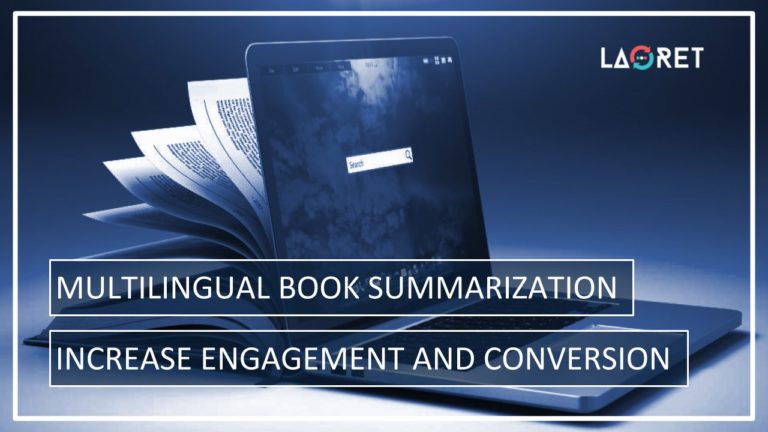Multilingual Book Summarization: Increase Engagement And Conversion
The publishing industry is highly competitive, and if it has shown us anything the last decade, it’s that it is capable of adapting to different buying cultures. So how do you compete in a digital world that has prioritized targeted searches, snap judgments, and ranking factors over comfortably browsing for anything that may appeal to a reader? That is where book summarization comes in.
Let us expand on how you can develop multilingual descriptions that convert, establish yourself as an authority within the digital realm, and devise strategies that speak to your users on a personal level.
Multilingual Book Summarization Strategies
So, what do we mean by book summarization? This can really refer to various processes. It can include:
- Book descriptions as posted on eCommerce Platforms
- A few pages of a preview of your book with an engaging description rather than simply a few selected pages.
- Micro-books that summarize larger works and highlight the key points and actionable items.
In essence, it is your book trying to sell itself to your audience with descriptions devised to boost conversion rates and improve ranking. And while these content types will certainly require specific qualities to be met even in the development stage in the source language (more tips on this later!), the translations themselves will also require a creative touch.
That is why, when planning your multilingual book summarization strategies, you have to plan for a fully human translation that can capture the mood and intent of your source language for your target audience.
Let’s get into specifics and dive a little deeper into what these categories entail and how you can develop the best strategy to maximize the potential of your book summary.
Micro-Books: How To Speak To International Business Leaders
The business world is always presenting new books and ideas that offer hacks to success or define a deeper understanding of modern business dynamics. But, with business also comes a tight timeframe, and not everyone can commit to reading full-length books on a rolling basis.
Introducing micro-books effective summaries that can be read in under 30 minutes. Does this work for every genre? No. it will be a bad idea to summarize fiction work since the emotion buildup is paramount but think about the books commonly written on business and other non-fiction topics. There may be biographical elements and an engaging narrative, but the heart of the story will boil down to actionable items that can be implemented into their professional lives. And these can easily be presented in a shorter form.
Offering multilingual book summaries will not only open you up to a whole new market, but it will also create new opportunities for the full-length work to sell in case the readers are tickled to read the whole story. Note that when developing a multilingual plan for micro-books, you should only offer these in the languages in which you have the original work available!

Devising A Fetching Multilingual Book Summary For eCommerce Platforms
So, what about the book descriptions offered on eCommerce Platforms such as Amazon? It might be easy to think that you can simply copy/paste a generic book description. But descriptions can serve as an effective way to engage readers as well as to tell Amazon and search engines what you are all about.
A quality description starts prior to the translation and already answers to some best practices that will promote user engagement and increase conversion.
Devising A Fetching Multilingual Book Summary For eCommerce Platforms
So, what about the book descriptions offered on eCommerce Platforms such as Amazon? It might be easy to think that you can simply copy/paste a generic book description. But descriptions can serve as an effective way to engage readers as well as to tell Amazon and search engines what you are all about.
A quality description starts prior to the translation and already answers to some best practices that will promote user engagement and increase conversion.
- Try to collect data on what readers like. The best data is collected from User-Generated Content such as reviews. If your book doesn’t have any reviews yet, research books similar to yours and investigate! Collect this data from various sources including Amazon, Barnes & Nobel, Kobo, and so on.
- From here, also try and integrate the words that people commonly use and integrate them into the description to increase familiarity and engagement. Just like Amazon’s A9 Algorithm1 states, they scan the words used in the description to determine where to place the book on their platform. So, the more research you perform, the better.
- Structure your description in such a way that is not only readable but scannable. This will benefit your potential buyers as well as the search engine.
- Test your book description within your target demographic and tweak the description as you go. For this, you can use tools such as PickFu,2 where you can create surveys on just about any topic.
Once you have created a successful description in the source language, you can engage professional translation & localization services to create a similar atmosphere in your target languages, fully adapted in linguistic as well as cultural potency.
Keyword Localization & Categories
Amazon’s previously mentioned A9 Algorithm made it pretty clear, keywords matter. And part of writing a functional book summary and description for online use is that users can find it. If readers are commonly trying to find interesting books for the term top translation tips, the description should be sculpted around this and other common keywords. So, make sure to perform keyword research and select the ones most descriptive and useful for your book.
But more than just identifying the useful keywords, they will need to be localized for multilingual audiences trying to find your book in their native language. Here, it might be tempting to just run your keywords through a Machine Translation Engine. But it is worth keeping in mind that the generic translation these engines produce, is never the optimal one to use in this situation.
While Machine Translation has its place within a well-developed content strategy, it should be avoided when performing Keyword Localization and any type of content that has marketing purposes, is complex or needs to create a genuine connection with the target audience. In these cases, you have to commit to human translation only.
That is why:
- The most suitable linguists are native, in-country professionals. They understand your audience and create translations your target audience is most familiar with. This means that they will never settle for a generic translation, but rather apply one that suits the country and region.
- Experienced linguists can take both language and culture into account. This also includes local sensitivities in religion or politics that could undermine your sales as well as your brand.
- Finally, a skilled linguist, especially one employed by a Language Service Provider (LSP), knows how to effectively utilize a Language (CAT) Tool. This allows for the translation process to be streamlined so that any future projects will be developed more efficiently, and it also adds a level of Quality Assurance.
Pro tip! Learn more about how international SEO and keyword localization can help you develop a sound, global strategy.
Multilingual Book Summarization And Email Marketing: Taking The Descriptions Beyond The Platform
If you have a description that converts well, why stop with just the platform? Why not consider using the description for targeted email marketing? E-mail Marketing still holds value within well-defined eCommerce marketing strategies. They can be automated, segmented by the buyer’s journey stage or interest, and the magic can happen.
However, while the process of sending out emails itself can be automated, the content should receive a little more TLC so that optimal trust is created between you and your buyers.
So, once you have released a new book that some of your customers are likely to appreciate based on their previous purchases, why not give the book summary or description a prominent place within a targeted email campaign?
Pro Tip! Learn more about how personalized content can be used to boost sales and attract new audiences in our blog on multilingual hyper-personalization and how it will define the future of international marketing.
Conclusion
When it comes to multilingual book summarization, it can be handled in different ways. Whether you need a description for an eCommerce Platform or are creating micro-books, what remains the same is that each summary should be created with your market in mind. Only this way, will you achieve your sales goals and create descriptions and summaries that actually convert. In this, it is crucial that you commit to human translation and enlist only the native professionals who know how your target audience ticks.
At Laoret, we hire only native, in-country professionals with experience in providing literary translations where creativity and cultural potency are prioritized.






